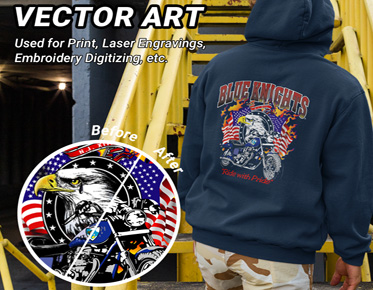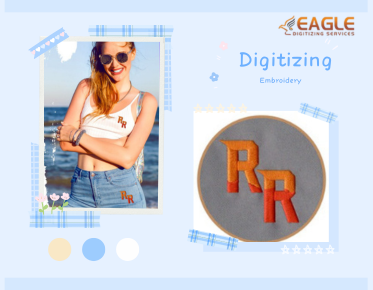Clash of the Titans: Digital Printing VS Screen Printing
When embarking on a printing project, selecting the right method can be as crucial as the design itself. Digital and screen printing are two popular techniques, each with its distinct advantages and limitations. Whether you're printing a batch of custom t-shirts, promotional materials, or home décor items, understanding the differences between digital and screen printing will help you make an informed decision tailored to your needs. For the premier online vector conversion, feel free to connect with us.
Understanding The Basics
What is Digital Printing? A Modern Approach
Digital printing is a contemporary method that involves directly printing digital images onto various surfaces using inkjet or laser printers. This technique eliminates the need for plates or screens, making it ideal for short runs and intricate designs. With digital printing, what you see on your computer screen can be replicated with stunning accuracy on your chosen material.
The Fundamentals of Screen Printing: Traditional Techniques
Screen printing, also known as silkscreen printing, is a traditional method that involves creating a stencil (or screen) and using it to apply layers of ink onto a substrate. Each color in the design requires a separate screen, making it well-suited for projects with fewer colors or simpler designs. Despite its age, screen printing remains popular due to its reliability and versatility.
Comparing Print Quality: Digital vs. Screen
Color Accuracy and Vibrancy: What to Expect from Each Method
Digital printing excels in color accuracy, offering a vast spectrum of hues and the ability to reproduce detailed gradients and photographs. Screen printing, on the other hand, produces vibrant colors with solid, opaque inks, which can be particularly striking on darker materials. However, achieving color consistency can be more challenging, especially with complex designs.
Detail and Resolution: The Fine Print of Each Technique
Digital printing offers high resolution and fine detail, making it suitable for intricate designs and photographic images. Screen printing, while capable of producing sharp images, might not capture the same level of detail, especially for very complex or multi-colored designs. The resolution of screen prints can also be affected by the mesh count of the screens used.
Best Applications for High-Resolution Designs
For designs requiring high resolution and photographic quality, digital printing is generally the better choice. It handles fine details and subtle color gradients with ease. Screen printing is best suited for simpler, bolder designs where durability and color vibrancy are more critical than fine detail.
Cost Considerations: Which Method is More Cost-Effective?
Comparing Initial Setup Costs and Equipment
Digital printing typically involves lower setup costs since it doesn’t require screens or plates. The initial investment is often in the printer itself, but this can be more economical for short-runs or one-off projects. Screen printing, however, requires the creation of screens and setup time, which can be more expensive upfront, especially for smaller quantities.
Cost Per Unit: When Digital Printing is More Affordable
For small quantities or custom orders, digital printing can be more cost-effective. It avoids the setup costs associated with screen printing and allows for on-demand printing. As quantities increase, the cost per unit for digital printing remains relatively stable, whereas screen printing becomes more economical for larger volumes due to its lower per-unit cost at scale.
Screen Printing: Economies of Scale and Bulk Orders
As quantity rises, screen printing gets more economical. The initial setup costs are offset by the lower cost per unit when printing in bulk. This method is ideal for large orders where the cost savings from the bulk production can outweigh the initial investment in screens and setup.
Production Time: Speed and Efficiency
How Digital Printing Offers Faster Turnaround
Digitized printing is renowned for its rapid production times. Since there is no need for setup like screens or plates, digital prints can be produced and delivered in a relatively short period. This makes it an excellent choice for projects with tight deadlines or last-minute orders.
The Time Required for Screen Printing Setup and Execution
Screen printing involves more preparation time, including screen creation and ink mixing. Each color requires a separate screen and printing pass, which can add to the overall production time. The setup process can be time-consuming, but once complete, the actual printing process can be relatively quick for large quantities.
Meeting Tight Deadlines: Which Method Wins?
For meeting tight deadlines, digital printing is often the winner due to its fast setup and immediate printing capabilities. Screen printing can handle large volumes efficiently but may not be the best choice for urgent orders due to its more involved setup process.
Material Compatibility: What Can You Print On?
Digital Printing: Best Fabrics and Surfaces
Digital printing works well on a variety of fabrics and surfaces, including cotton, polyester, and synthetic blends. It also supports non-textile materials such as paper, metal, and glass, offering a high degree of flexibility in material choice. The method is ideal for detailed designs and full-color prints on diverse substrates.
Screen Printing: From Textiles to Promotional Items
Screen printing is highly versatile and can be used on a wide range of materials, including textiles, ceramics, plastics, and metals. It’s particularly well-suited for printing on garments, banners, and promotional items. However, the type of ink and screen mesh must be matched to the material to ensure optimal results.
How Each Method Handles Different Material Types
Digital printing is more adaptable to various materials and can produce high-quality prints on both standard and unconventional surfaces. Screen printing is effective on many materials but requires specific inks and techniques tailored to each type. The choice between methods often depends on the material’s characteristics and the desired print quality.
Design Complexity and Flexibility
Digital Printing: Ideal for Complex and Multi-Colored Designs
Digital printing shines when it comes to complex and multi-colored designs. It supports a wide range of colors and intricate details without the need for multiple screens. This method is perfect for designs with gradients, fine lines, or photographic elements that require precise reproduction.
Screen Printing: Best for Simple, Bold Designs
Screen printing is best suited for simpler, bold designs with fewer colors. The process involves creating separate screens for each color, making it less efficient for designs with complex color schemes. However, it excels at producing vibrant, solid colors and large, graphic elements.
Adapting Designs for Each Printing Method
When adapting designs for digital printing, focus on achieving high resolution and color accuracy. For screen printing, simplify designs to accommodate the screen separation process and consider using solid, contrasting colors. Each method requires a tailored approach to ensure the best results.
Environmental Impact: Which Method is Greener?
Digital Printing: Waste and Resource Efficiency
Digital printing tends to be more resource-efficient, generating less waste compared to screen printing. It eliminates the need for screens and uses only the ink required for each print. However, the environmental impact can vary depending on the type of ink and materials used.
Screen Printing: Traditional Practices and Environmental Concerns
Screen printing can involve significant waste, including excess ink and screen materials. Traditional practices often use plastisol inks, which are not biodegradable. However, advancements in eco-friendly inks and sustainable practices are helping to reduce the environmental footprint of screen printing.
Sustainable Practices and Innovations in Both Methods
Both digital and screen printing industries are evolving towards more sustainable practices. Digital printing is increasingly adopting water-based and eco-friendly inks, while screen printing is incorporating sustainable inks and recycling programs. Innovations in both methods aim to minimize environmental impact and promote greener printing solutions.
Durability and Longevity of Prints
How Digital Prints Hold Up Over Time
Digital prints generally offer good durability, especially when using high-quality inks and substrates. However, the longevity of digital prints can be influenced by factors such as exposure to sunlight and washing conditions. Protective coatings can enhance the durability of digital prints, particularly on textiles.
The Durability of Screen Prints and Their Resistance to Wear
Screen prints are renowned for their durability and resistance to wear. The ink used in screen printing bonds well with the substrate, providing a robust and long-lasting finish. This method is particularly effective for items that undergo frequent use or washing, such as apparel.
Factors Affecting the Longevity of Each Print Type
The longevity of both digital and screen prints is influenced by factors like ink quality, material type, and exposure conditions. Proper care and maintenance can extend the life of prints, with digital prints benefiting from protective finishes and screen prints from high-quality inks and proper curing techniques.
Customization and Personalization Options
Digital Printing: Custom Orders and On-Demand Printing
Digital printing excels in customization and on-demand printing. It allows for the production of unique, personalized items without the need for extensive setup. This method is ideal for one-off designs, custom orders, and projects requiring variable data.
Screen Printing: Bulk Customization and Variations
Screen printing offers customization options for bulk orders, allowing for variations in design and color. While it’s less flexible for one-off items, it supports a range of customization for larger quantities. This method is well-suited for producing customized merchandise and promotional items.
The Flexibility of Each Method for Personalized Projects
Digital printing provides flexibility for highly personalized projects with diverse design needs. Screen printing is ideal for bulk customization where specific variations can be accommodated. Both methods offer unique advantages depending on the scale and nature of the customization required.
Color Matching and Pantone Systems
How Digital Printing Handles Color Matching
Digital printing offers advanced color-matching capabilities, often using color management systems to ensure accuracy. Pantone colors can be matched closely, though exact reproduction may vary depending on the printer and ink used. Digital printing excels in handling a broad range of colors with precision.
Screen Printing and Pantone Colors: Achieving Consistent Hues
Screen printing relies on Pantone matching to achieve consistent hues across prints. By using Pantone swatches, printers can ensure color accuracy and consistency. However, color matching can be affected by factors such as ink mixing and screen setup.
Matching Colors Across Different Printing Methods
Achieving consistent color matching across digital and screen printing can be challenging due to the inherent differences in each method. It’s important to communicate color specifications clearly and understand that some variations may occur. Collaborating with experienced printers can help achieve the best color results.
Post-Printing Processes: Finishing Touches
Digital Printing Finishing Options: Coatings and Treatments
Digital prints can be enhanced with various finishing options, including coatings, laminations, and UV treatments. These finishes add durability, improve appearance, and offer additional protection. Finishing treatments can enhance the overall quality and longevity of digital prints.
Screen Printing Post-Processing: Curing and Drying
Screen prints require curing or drying to set the ink and ensure durability. This process involves heating the printed item to fix the ink and improve its resistance to wear. Proper curing is essential for achieving high-quality, long-lasting screen prints.
Adding Value to Prints with Additional Finishes
Both digital and screen prints can benefit from additional finishes that enhance their appearance and functionality. Consider options such as embossing, foil stamping, or special coatings to add value and differentiate your printed items. Should this post have fanned the flames of your interest in vector art services in usa and you desire to delve deeper, don't hesitate to communicate with us.
Choosing between digital and screen printing involves evaluating various factors, including project requirements, budget, and material compatibility. Digital printing offers precision and flexibility for short runs and complex designs, while screen printing provides durability and cost-effectiveness for larger quantities. Knowing the benefits and drawbacks of each approach will help you choose the one that will work best for your printing requirements.



